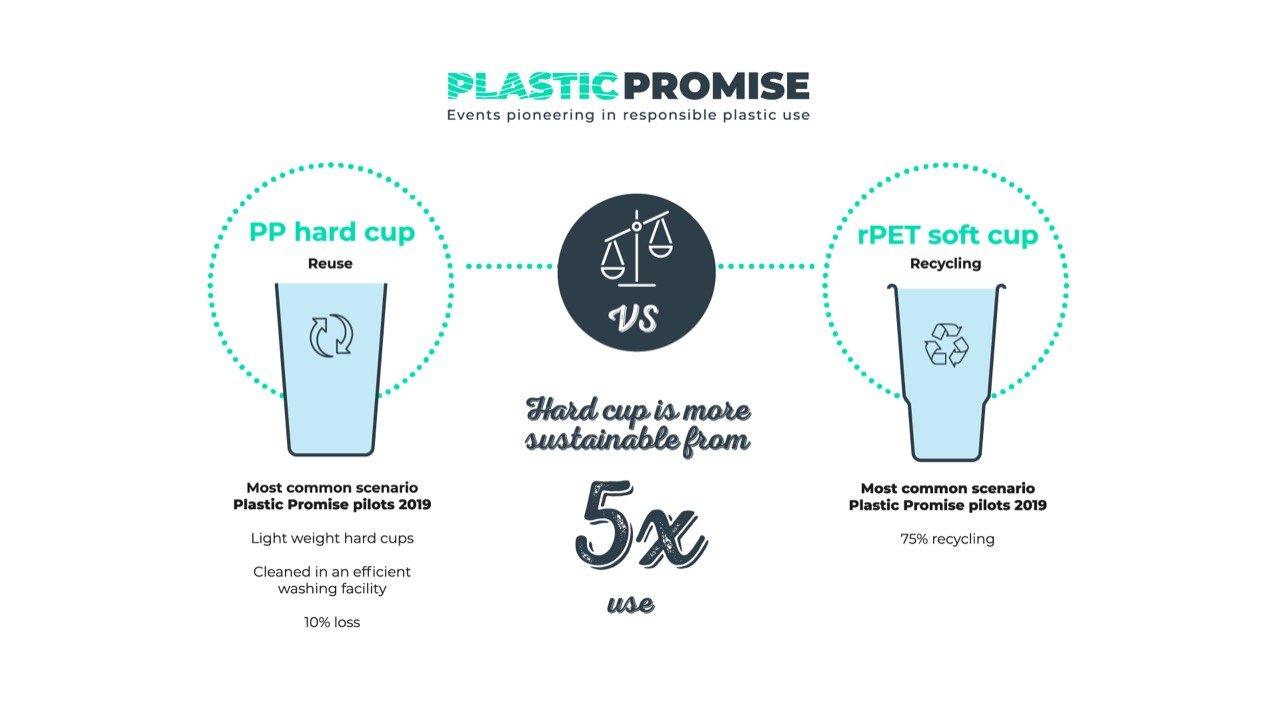Reusable or recyclable cups: which is the most sustainable choice at events?
The LCA Centre, commissioned by Rijkswaterstaat and in collaboration with Plastic Promise, has published a scientific study on the environmental impact of different types of plastic drink cups for events. Would you like to know what the impact of reusable vs. recyclable cups is and what choices you as an organiser or policy maker can make to reduce that impact? In this article, we'll share the most important results and solutions for waste-free cup systems.
The need for clarity on the environmental impact of different cup types was identified by Plastic Promise, a Dutch platform for event industry leaders to share their knowledge and their ambitions for reducing disposable plastic usage and finding high-quality recycling solutions for used plastic.
Waste-free cup systems
Laura van de Voort, co-founder of Green Events and project manager for Plastic Promise: "In the last year and a half, we have worked closely with a wide range of event organisers and beverage brands to set a new standard in 2019: waste-free cup systems at events".
When it comes to waste-free, or circular, cup systems, there are two options: reusing hard cups or recycling soft cups. But in both cases, the cups need to be returned to keep them from entering the waste stream. Deposit-based return systems or linking returns to other incentives, like cup-coins, have led to the best results.
Research
This study has looked at multiple real-life situations, and we have collected information from a wide range of Plastic Promise participants about the types of cups they use and their return percentages. Several reusable cup suppliers and recycling companies were also involved in the research. The study compared a total of nine cups – three PP re-usable hard cups from three different suppliers and six recyclable soft cups made from recycled PET (rPET), PP and PLA from multiple different suppliers.
Impact factors
The environmental benefits depend on a combination of factors. The key elements for reusable cups are the loss rate and washing efficiency. For recyclable cups, the recycling rate (the number of cups actually recycled) and the type of cup are the most important factors.
But consistent factors like country of origin and transport distance of course also play a role. Both the reusable and recyclable cup systems have multiple impact factors, which come together to determine the total environmental impact. That makes one-to-one comparisons of these systems impossible.
Material choice
This study proves that the path towards a waste-free cup system, which most Plastic Promise leaders started down in 2018, is the right one. As for reusable cups, the cup made from PP has the least impact on the environment.
The reusable PP cup also had the least environmental impact, but the material cannot be recycled from cup to cup (circular). Despite the fact that the production process doesn't use raw fossil materials, PLA still has the greatest environmental impact. At the moment, rPET is the only material that can be processed in a circular way, which is the preferred option. But a prerequisite for circular recycling is that the cups have to be collected in a clean monostream (no waste or other types of plastic) and they must be ink free.
Systemic thinking
"There is no absolute winner" says Agnieszka van Batavia from The LCA Centre, who was the project manager on the study. For example, a low-impact, reusable hard cup that is washed efficiently is less harmful to the environment than any recyclable soft cup, but the hard cup failure does need to stay below 25%. On the other hand, even with a systemic loss of only 2%, that same hard cup quickly loses out to a soft cup with a low environmental impact if the hard cups are washed inefficiently.
This kind of insight makes it clear that when analysing circular solutions, it's important to think in terms of systems and not in terms of individual products and activities. It's not just material or supplier choice that makes a difference, or the way the deposit system is set up, but all of those choices together are what can make a system more sustainable. Agnieszka emphasizes that this holistic approach has never been used before, which sets this study apart from other LCA studies on drink cups.
Reuse more sustainable from at least 5x reuse
To get a clearer picture of the actual tipping point, we have compared two most common scenarios using results from the 2019 Plastic Promise Pilots. When using a lightweight reusable PP cup that is cleaned efficiently and with a loss of 10% versus a recyclable rPET cup with a recycling percentage of 75%, the reusable cup is more sustainable if it is reused at least 6 times. That reuse could be at any point in the life cycle of the cups, so it doesn't have to happen during a single event.
The first version of the report concluded that a reusable cup should be used at least 6 times. Due to corrections in the data, this turning point has been set at 5.
Keep out of the incinerator
According to Laura van de Voort, "the choice to go with reusable or high-quality recyclable cups is one that's best made by individual organisations, as long as the cups don't end up in the incinerator. There are other factors like logistical challenges that come into play here, not just the environment. This study can give organisers some guidance as they try to make the right decision".
Why now?
Unfortunately, there isn't a clear timeline on the horizon for the events industry to reopen. Nevertheless, this is a good time to work on sustainable solutions, allowing organisations to develop more resilient, sustainable policies and put them into practice when events reopen.
Are you going to start drawing up a plan for a waste-free cup system in the near future? Then read through the study carefully and start working with your partners and suppliers now.


